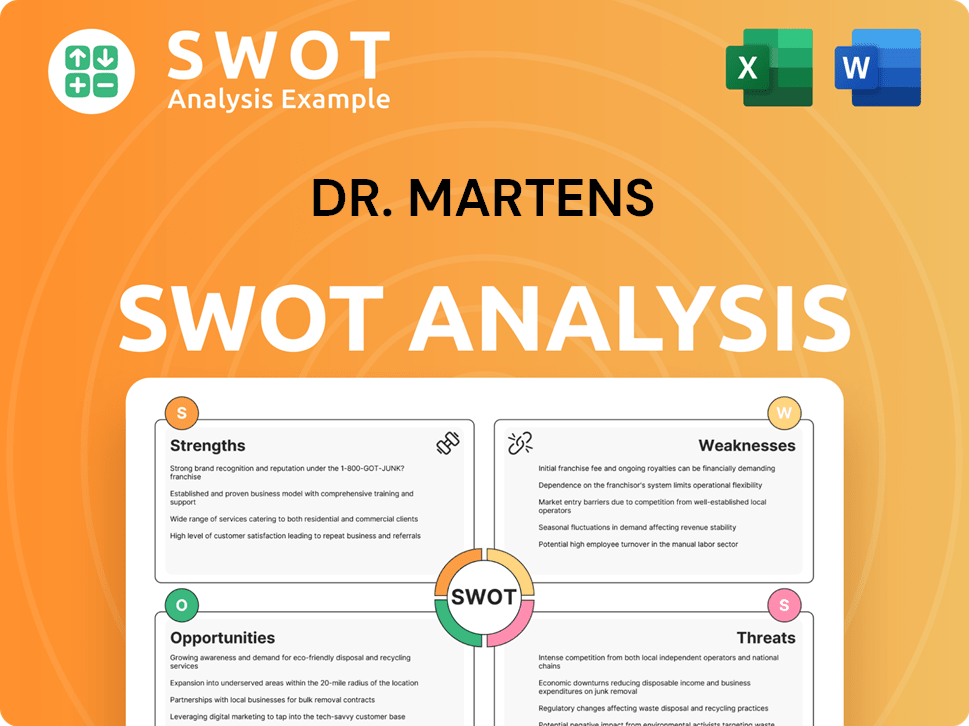Dr. Martens Bundle
Can Dr. Martens Maintain Its Iconic Status in a Crowded Market?
Born from post-war ingenuity, Dr. Martens has become a global icon, but how does it fare against the relentless Dr. Martens SWOT Analysis and ever-changing dynamics of the footwear industry? This exploration dives deep into the Dr. Martens competitive landscape, examining its key rivals and the strategies employed to maintain its position in the global shoe market. From humble beginnings to a symbol of rebellion, the brand's journey is a testament to its enduring appeal.

Understanding the Dr. Martens market analysis is crucial for any investor or business strategist. This analysis will dissect the competitive advantages of Dr. Martens, providing insights into its brand positioning and pricing strategies relative to its competitors. We will also explore the Dr. Martens competition, offering a comprehensive overview of the top footwear companies challenging the brand and their respective market shares.
Where Does Dr. Martens’ Stand in the Current Market?
Dr. Martens carves out a unique space in the global footwear market, distinguished by its strong brand identity and dedicated customer base. The company's core business revolves around its iconic boots and shoes, sold through wholesale, direct-to-consumer (DTC) retail, and e-commerce channels. This multifaceted approach allows for broad market penetration and direct engagement with consumers. Geographically, the brand boasts a significant global footprint, with a strong presence in Europe, North America, and Asia.
The brand's appeal spans a diverse consumer base, from fashion-conscious individuals to those seeking durable and comfortable everyday footwear. Dr. Martens has largely maintained its premium positioning, which has helped it to establish a loyal following. However, the company has also embraced digital transformation to enhance its reach and adapt to evolving market dynamics. This adaptability is crucial in the competitive footwear industry.
For the fiscal year ending March 31, 2024, Dr. Martens reported group revenue of £972.5 million, a 5% decline compared to the previous year. Pre-tax profit also saw a significant drop to £97.9 million from £214.3 million. This indicates a challenging period, yet the brand's underlying strength and global appeal remain. The company continues to hold a particularly strong position in markets where its counter-cultural heritage resonates deeply, such as the UK and parts of North America. Understanding the Dr. Martens competition is vital for assessing its market position.
Dr. Martens' operations center around the design, manufacturing, and distribution of footwear and related accessories. The company utilizes a mix of owned retail stores, wholesale partnerships, and a robust e-commerce platform to reach its customers. This multi-channel strategy allows for broad market coverage and direct interaction with consumers.
The value proposition of Dr. Martens lies in its durable, iconic, and stylish footwear. The brand offers products that appeal to a wide range of consumers, from those seeking practical work boots to fashion-forward individuals. The brand's heritage and association with counter-culture also contribute to its appeal.
The Dr. Martens market analysis reveals a strong brand presence within the premium casual and alternative footwear segments. The company's brand positioning strategy emphasizes durability, style, and cultural relevance. This strategy has allowed it to maintain a premium price point and cultivate a loyal customer base. Examining the Dr. Martens competitive landscape provides further insights.
- Dr. Martens has a strong presence in key markets like the UK, North America, and parts of Asia.
- The brand targets a diverse consumer base, including fashion-conscious individuals and those seeking durable footwear.
- The company's financial performance in recent years reflects both its strengths and challenges within the footwear industry.
- Understanding the boot brands that compete with Dr. Martens is crucial for strategic planning.
Dr. Martens SWOT Analysis
- Complete SWOT Breakdown
- Fully Customizable
- Editable in Excel & Word
- Professional Formatting
- Investor-Ready Format

Who Are the Main Competitors Challenging Dr. Martens?
The Growth Strategy of Dr. Martens is significantly influenced by its competitive environment within the footwear industry. Understanding the Dr. Martens competition is crucial for assessing its market position and future prospects. This analysis helps to clarify Dr. Martens' market share compared to competitors and evaluate Dr. Martens' competitive strategy.
Dr. Martens market analysis reveals a landscape where various brands vie for consumer attention. The Dr. Martens competitive landscape is shaped by both direct and indirect competitors, each employing different strategies to capture market share. These competitive dynamics are influenced by fashion trends, consumer preferences, and economic conditions.
Direct competitors of Dr. Martens include brands that offer similar products, such as durable boots and footwear with a strong heritage. These brands often target similar demographics and compete on factors like quality, style, and brand reputation.
Timberland is a key direct competitor, known for its rugged boots and outdoor apparel. It competes with Dr. Martens by focusing on durability and a similar target audience. Timberland's market share fluctuates based on fashion trends and seasonal demands.
Red Wing Shoes, another direct competitor, emphasizes workwear and heritage craftsmanship. It competes with Dr. Martens by offering high-quality, durable footwear. Red Wing's brand positioning appeals to consumers seeking long-lasting products.
Indirect competitors challenge Dr. Martens by competing for consumer spending on footwear but may offer different product styles. These brands often have broader product lines or target different segments of the shoe market.
Birkenstock, while offering a different aesthetic, competes for consumers seeking comfortable and stylish casual footwear. It challenges Dr. Martens by appealing to a different segment of the shoe market. Birkenstock's market share is influenced by fashion trends.
Major athletic footwear companies like Nike and Adidas compete for consumer discretionary spending on footwear. They often leverage vast marketing budgets and rapid innovation cycles. These brands compete with Dr. Martens for overall market share.
The footwear industry is dynamic, with shoe market trends influencing the competitive landscape. Top footwear companies challenging Dr. Martens include both established brands and emerging players. Dr. Martens vs. other shoe brands involves a constant battle for market share. Competitive advantages of Dr. Martens include its brand heritage and distinctive style. Dr. Martens' pricing strategy compared to competitors is a key factor in its market performance. The future of Dr. Martens in the footwear market depends on its ability to adapt to changing consumer preferences and competitive pressures. Dr. Martens' target market competitors are those brands that appeal to similar consumer segments. Market analysis of Dr. Martens' rivals is essential for understanding its strategic position.
Several factors drive competition in the footwear market. These include brand reputation, product innovation, pricing, distribution networks, and marketing strategies. Understanding these factors is crucial for assessing Dr. Martens' key competitors and their strategies.
- Brand Reputation: Established brands with strong reputations for quality and style often have a competitive advantage.
- Product Innovation: Introducing new designs, materials, and technologies can attract consumers and differentiate a brand.
- Pricing Strategy: Competitive pricing is essential for attracting customers and maintaining market share.
- Distribution Networks: Effective distribution channels, including online and physical stores, are crucial for reaching consumers.
- Marketing and Promotion: Successful marketing campaigns and celebrity endorsements can significantly impact brand visibility and sales.
Dr. Martens PESTLE Analysis
- Covers All 6 PESTLE Categories
- No Research Needed – Save Hours of Work
- Built by Experts, Trusted by Consultants
- Instant Download, Ready to Use
- 100% Editable, Fully Customizable

What Gives Dr. Martens a Competitive Edge Over Its Rivals?
The competitive landscape for Dr. Martens is shaped by its strong brand identity and enduring appeal in the footwear industry. The company's iconic design, characterized by its air-cushioned sole, yellow stitching, and grooved edges, has cultivated immense customer loyalty. This brand recognition allows the company to maintain a premium pricing strategy, a key element in its competitive strategy.
Dr. Martens' competitive advantages also include its reputation for durability and quality. The boots' robust construction and longevity appeal to consumers seeking long-lasting products. This is supported by features like the Goodyear welt construction, which enables sole replacement, extending the product's lifespan. The firm's well-established global distribution network, combining wholesale partnerships with a growing direct-to-consumer presence, further strengthens its market position.
However, the company faces challenges from fast-fashion brands and shifts in consumer preferences. Imitation products and the rising popularity of lighter, athletic footwear pose threats. A thorough analysis of the Dr. Martens competitive landscape is crucial for understanding its position in the market. For more insights, consider exploring the Target Market of Dr. Martens.
Dr. Martens benefits from unparalleled brand equity, built over decades. The instantly recognizable design and association with authenticity and individuality drive customer loyalty. This strong brand recognition allows the company to maintain premium pricing in the competitive footwear market.
The perceived durability and quality of Dr. Martens footwear are significant advantages. The boots' robust construction and longevity appeal to consumers seeking long-lasting products. Features like Goodyear welt construction contribute to the product's extended lifespan.
Dr. Martens has a well-established global distribution network, enhancing its market reach. This includes wholesale partnerships and a growing direct-to-consumer presence. The omnichannel approach provides greater control over brand messaging and customer experience.
Dr. Martens employs a premium pricing strategy, supported by its strong brand and product quality. This strategy allows the company to maintain healthy profit margins. The ability to command higher prices is a key competitive advantage.
Dr. Martens faces challenges from fast-fashion brands and shifts in consumer preferences. Imitation products and the rising popularity of lighter, athletic footwear pose threats to its market share. Understanding these challenges is crucial for maintaining its competitive edge.
- Fast-fashion brands offering similar aesthetics at lower price points.
- Shifts in consumer preferences towards lighter, more athletic footwear.
- Maintaining brand relevance in a changing market.
- Adapting to evolving consumer demands and trends.
Dr. Martens Business Model Canvas
- Complete 9-Block Business Model Canvas
- Effortlessly Communicate Your Business Strategy
- Investor-Ready BMC Format
- 100% Editable and Customizable
- Clear and Structured Layout

What Industry Trends Are Reshaping Dr. Martens’s Competitive Landscape?
The competitive landscape for Dr. Martens is shaped by evolving industry trends and consumer preferences. Analyzing the Dr. Martens competition requires understanding these broader market dynamics. The footwear industry, including boot brands, is influenced by technological advancements, shifts in consumer behavior, and regulatory changes. A thorough Dr. Martens market analysis is crucial for navigating these complexities.
Dr. Martens' market share compared to competitors is influenced by its ability to adapt to challenges such as fast fashion and supply chain vulnerabilities. The company's strategic focus includes strengthening direct-to-consumer channels and innovating while staying true to its core brand identity. In fiscal year 2024, Dr. Martens faced a 54% drop in profit due to weak demand in the US and operational issues, highlighting the need for effective strategies to mitigate risks. Understanding Dr. Martens' key competitors and their strategies is essential for its future success.
Technological advancements in e-commerce and digital marketing are reshaping how footwear brands engage consumers. Regulatory changes regarding environmental and labor practices are increasing in importance. Consumer preferences are shifting towards greater comfort, sustainability, and personalization, influencing the shoe market trends.
The rise of fast fashion, which replicates trends quickly and offers lower-priced alternatives, poses a significant challenge. New market entrants leveraging innovative materials or direct-to-consumer models could disrupt the market. Declines in demand for Dr. Martens' specific aesthetic and increased competition from brands offering similar durability at lower prices are also threats.
Emerging markets offer significant growth opportunities due to a growing middle class with increased disposable income. Product innovations, such as expanding into new footwear categories and using advanced materials, present further avenues for growth. Strategic partnerships with designers or other brands can help maintain cultural relevance.
Dr. Martens is focused on strengthening its direct-to-consumer channels, optimizing its supply chain, and continuing to innovate while staying true to its core brand identity. The company aims to improve operational efficiency and regain momentum in key markets like the US. Understanding the Dr. Martens competitive landscape is vital for these efforts.
To maintain its market position, Dr. Martens must navigate shifts in consumer preferences and address potential disruptions. The company is prioritizing direct-to-consumer sales and expanding its vegan-friendly offerings. Recent financial results, such as the 54% profit drop in fiscal year 2024, underscore the need for strategic adjustments.
- Embracing digital transformation to boost online sales.
- Expanding product lines to meet evolving consumer demands.
- Optimizing supply chain operations for efficiency and resilience.
- Exploring strategic partnerships to enhance brand relevance.
Dr. Martens Porter's Five Forces Analysis
- Covers All 5 Competitive Forces in Detail
- Structured for Consultants, Students, and Founders
- 100% Editable in Microsoft Word & Excel
- Instant Digital Download – Use Immediately
- Compatible with Mac & PC – Fully Unlocked

Related Blogs
- What are Mission Vision & Core Values of Dr. Martens Company?
- What is Growth Strategy and Future Prospects of Dr. Martens Company?
- How Does Dr. Martens Company Work?
- What is Sales and Marketing Strategy of Dr. Martens Company?
- What is Brief History of Dr. Martens Company?
- Who Owns Dr. Martens Company?
- What is Customer Demographics and Target Market of Dr. Martens Company?
Disclaimer
All information, articles, and product details provided on this website are for general informational and educational purposes only. We do not claim any ownership over, nor do we intend to infringe upon, any trademarks, copyrights, logos, brand names, or other intellectual property mentioned or depicted on this site. Such intellectual property remains the property of its respective owners, and any references here are made solely for identification or informational purposes, without implying any affiliation, endorsement, or partnership.
We make no representations or warranties, express or implied, regarding the accuracy, completeness, or suitability of any content or products presented. Nothing on this website should be construed as legal, tax, investment, financial, medical, or other professional advice. In addition, no part of this site—including articles or product references—constitutes a solicitation, recommendation, endorsement, advertisement, or offer to buy or sell any securities, franchises, or other financial instruments, particularly in jurisdictions where such activity would be unlawful.
All content is of a general nature and may not address the specific circumstances of any individual or entity. It is not a substitute for professional advice or services. Any actions you take based on the information provided here are strictly at your own risk. You accept full responsibility for any decisions or outcomes arising from your use of this website and agree to release us from any liability in connection with your use of, or reliance upon, the content or products found herein.